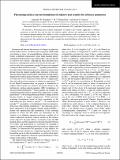| dc.contributor.author | Rodriguez, Alejandro W. | |
| dc.contributor.author | Reid, M. T. Homer | |
| dc.contributor.author | Johnson, Steven G. | |
| dc.date.accessioned | 2013-08-30T14:24:02Z | |
| dc.date.available | 2013-08-30T14:24:02Z | |
| dc.date.issued | 2012-12 | |
| dc.date.submitted | 2012-12 | |
| dc.identifier.issn | 1098-0121 | |
| dc.identifier.issn | 1550-235X | |
| dc.identifier.uri | http://hdl.handle.net/1721.1/80323 | |
| dc.description.abstract | We describe a fluctuating-surface-current formulation of radiative heat transfer, applicable to arbitrary geometries in both the near and far field, that directly exploits efficient and sophisticated techniques from the boundary-element method. We validate as well as extend previous results for spheres and cylinders, and also compute the heat transfer in a more complicated geometry consisting of two interlocked rings. Finally, we demonstrate how this method can be adapted to compute the spatial distribution of heat flux on the surfaces of the bodies. | en_US |
| dc.description.sponsorship | United States. Defense Advanced Research Projects Agency (Contract N66001-09-1-2070-DOD) | en_US |
| dc.description.sponsorship | United States. Air Force Office of Scientific Research. Multidisciplinary University Research Initiative (Complex and Robust On-chip Nanophotonics Grant FA9550-09-1-0704) | en_US |
| dc.language.iso | en_US | |
| dc.publisher | American Physical Society | en_US |
| dc.relation.isversionof | http://dx.doi.org/10.1103/PhysRevB.86.220302 | en_US |
| dc.rights | Article is made available in accordance with the publisher's policy and may be subject to US copyright law. Please refer to the publisher's site for terms of use. | en_US |
| dc.source | APS | en_US |
| dc.title | Fluctuating-surface-current formulation of radiative heat transfer for arbitrary geometries | en_US |
| dc.type | Article | en_US |
| dc.identifier.citation | Rodriguez, Alejandro W., M. T. Homer Reid, and Steven G. Johnson. “Fluctuating-surface-current formulation of radiative heat transfer for arbitrary geometries.” Physical Review B 86, no. 22 (December 2012). © 2012 American Physical Society | en_US |
| dc.contributor.department | Massachusetts Institute of Technology. Department of Mathematics | en_US |
| dc.contributor.mitauthor | Rodriguez, Alejandro W. | en_US |
| dc.contributor.mitauthor | Reid, M. T. Homer | en_US |
| dc.contributor.mitauthor | Johnson, Steven G. | en_US |
| dc.relation.journal | Physical Review B | en_US |
| dc.eprint.version | Final published version | en_US |
| dc.type.uri | http://purl.org/eprint/type/JournalArticle | en_US |
| eprint.status | http://purl.org/eprint/status/PeerReviewed | en_US |
| dspace.orderedauthors | Rodriguez, Alejandro W.; Reid, M. T. Homer; Johnson, Steven G. | en_US |
| dc.identifier.orcid | https://orcid.org/0000-0001-7327-4967 | |
| mit.license | PUBLISHER_POLICY | en_US |
| mit.metadata.status | Complete | |
